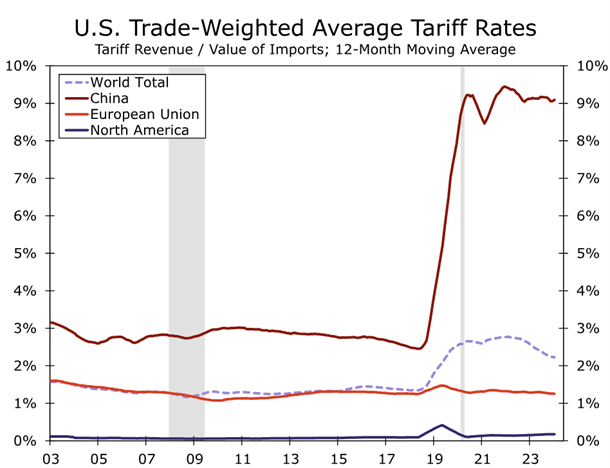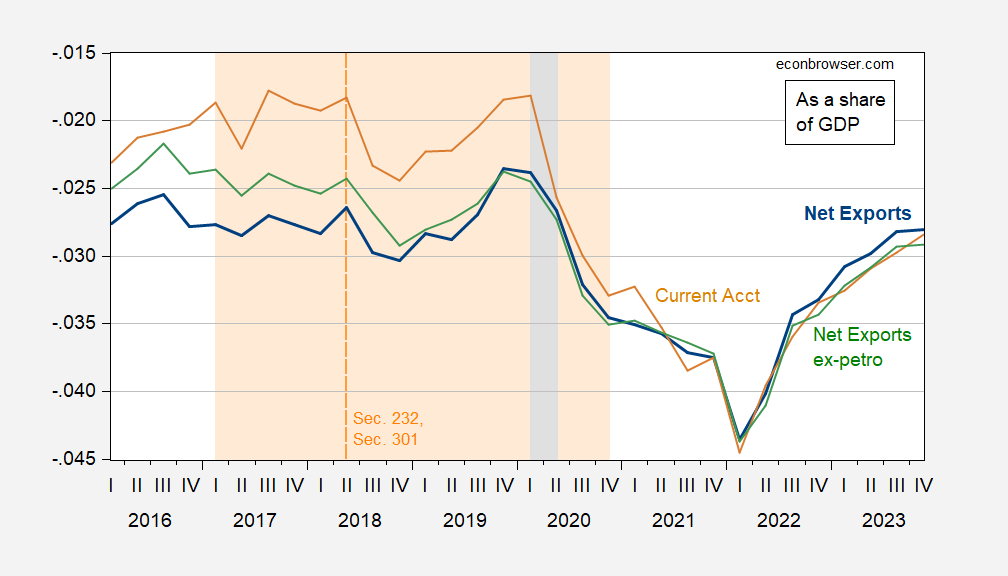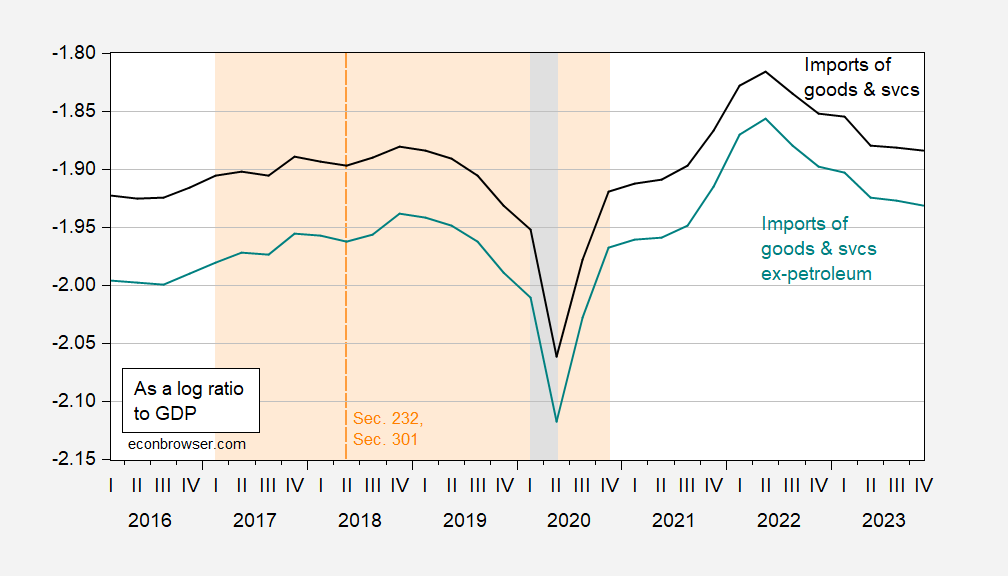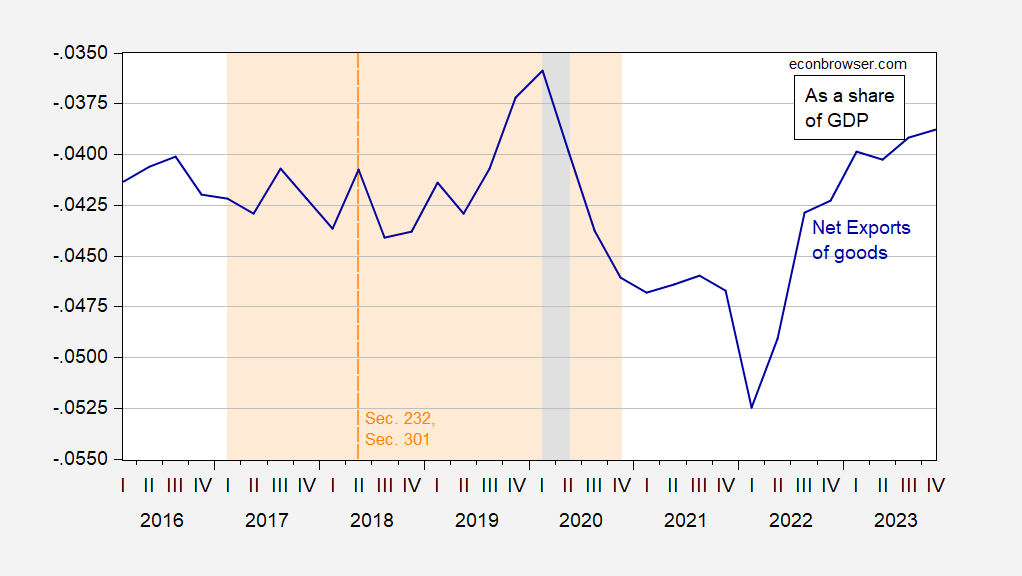A flurry of investment bank newsletters (Wells Fargo, GS) impels me to look at what happened to the aggregate trade balance in the wake of Trump’s tariff hikes:
Source: Wells Fargo.
The US trade-weighted tariff rate against world imports roughly doubled to nearly 3%. What happened to aggregate net exports and the current account, expressed as a share of GDP?
Figure 1: Net exports to GDP (bold blue), net exports ex-petroleum (green), and current account (tan), all as share of GDP. Trump administration shaded orange, dashed line at start of Section 232 and Section 301 actions. NBER defined recession dates shaded gray. Source: BEA, NBER, and author’s calculations.
At the beginning of the Trump Administration, the net exports to GDP ratio was -2.8%; by the end (2020Q4), it was -3.5%. What about excluding petroleum imports and exports? Then the deterioration was even worse — going from -2.4% to -3.5%.
What if we start from the real start of the trade war, 2018Q2. Then the net exports ratio declines from -2.6% to -3.5% by administration’s end.
What about imports — rather than the trade balance? Here, the change in imports is hard to see.
Figure 2: Imports to GDP (black), imports ex-petroleum (teal), both in logs of Ch.2017$. Trump administration shaded orange, dashed line at start of Section 232 and Section 301 actions. NBER defined recession dates shaded gray. Source: BEA, NBER, and author’s calculations.
Imports do decline starting in 2019, but I’d attribute that more to the strengthening dollar than tariffs. In any case, by the end of the Trump administration, imports ex-petroleum is about the same as share of real GDP as at the start of the tariff war.
Since Mr. Trump doesn’t believe that trade balance calculations should include services, I include the evolution of the goods (only) trade balance.
Figure 3: Net exports of goods to GDP (dark blue), as share of GDP. Trump administration shaded orange, dashed line at start of Section 232 and Section 301 actions. NBER defined recession dates shaded gray. Source: BEA, NBER, and author’s calculations.
That too declines.
So what about Mr. Trump’s statement:
“For many, many years, the United States has suffered through massive trade deficits. That’s why we have $20 trillion in debt. So we’ll be changing that.” June 30, 2017
Here’s the NIIP to GDP ratio.
Figure 4: Net international investment position (ex-derivatives) as share of GDP. Trump administration shaded orange, dashed line at start of Section 232 and Section 301 actions. NBER defined recession dates shaded gray. Source: BEA, NBER, and author’s calculations.
Well, not quite “mission accomplished”. At the start of the tariff war, the NIIP was -43% of GDP; at the end of the Trump administration, the NIIP was -67%. While changes in the NIIP are heavily influenced by changes in the exchange rate, it’s also true that the cumulated current account (an alternative measure of NIIP not subject to such large exchange rate related valuation changes) went from -50.3% to -53.0% over this same period.





Is it correct to refer to them as the Trump tariffs when they have continued under Biden? Wouldn’t they be the Biden tariffs now?
joseph: Yes, I suppose, in the same sense that the tariffs on light trucks should be called the Johnson-Nixon-Ford-Carter-Reagan-G.H.W.Bush-Clinton-G.W.Bush-Obama-Trump-Biden tariffs.
I think they continued to call it ObamaCare even after Trump took it over.
I see both sides on this discussion. Certainly changing the healthcare system is a little more difficult than changing the tariffs, so I don’t think it’s an apt comparison. If Biden wanted to change the tariffs he could have, so in some senses, they are Biden’s tariffs now. Each man has played some part in the situation, whether you see it as good or bad.
Frankly what I would like to see is more actions taken by federal agents against Chinese buying American land and using it for shady distribution of illegal marijuana sales. And it’s looking more and more like, because of federal agency’s inaction on illegal marijuana plantations that apparently the Chinese are bribing federal law enforcement to “look the other way”. That bothers me more right now than tariffs. Where are all the Chinese marijuana revenues on American based plantations going?? And why doesn’t the FBI care at all about that nefarious activity happening right under their nose, and not very difficult to find. It reminds me of all the Saudis/Arabs taking pilot training before 9-11 and the FBI seemingly playing dumb.
;At the beginning of the Trump Administration, the net exports to GDP ratio was -2.8%; by the end (2020Q4), it was -3.5%.’
Joan Robinson coined the term Beggar Thy Neighbor.
For Trump we have to amend that to Get Run Over by Thy Neighbor.
“Although the precise origin of the term beggar-thy-neighbor is not known, Adam Smith, the Scottish philosopher who is also considered to be the founder of modern economics, made a reference to it when he critiqued mercantilism, the dominant economic system in Europe from the 16th to the 18th century. According to Smith, the doctrine of mercantilism taught that nations should beggar all their neighbours to maximize economic gains. Smith believed that long-term gains from free trade would far outweigh the short-term benefits that might be derived from the protectionist policies advocated by the mercantilists. Economists after Smith confirmed his belief through research that showed that adopting such policies could trigger trade wars, a situation in which countries repeatedly retaliate against each other by raising tariffs on each other’s products. Trade wars tend to push the countries involved in them toward autarky, a system of economic self-sufficiency and limited trade, which could be detrimental for economic growth.”
https://www.britannica.com/money/beggar-thy-neighbor-policy
Last I checked Caitlin Clark did not coin the term “logo three”, but our staff of adept researchers is working to confirm.
Speaking of Caitlin Clark – she played great yesterday but South Carolina has a very good team including a stacked bench. UConn men takes on Purdue tonight!
Alas the Wells Fargo link send us to:
BlueMatrix is in the process of moving our Production services
BlueMatrix Production services will be unavailable for up to 12 hours on the 6th of April, from 7am to 7pm EDT for our data center move.
The Wells Fargo link is now working. Their discussion is well worth the read.
Ever-so-slightly on topic, Canadian policy makers and legislators are all intensely focused on the trade implications of the coming election. Not just trade, but trade in a big way.
As a Wisconsinite I found Trump’s trade wars to be stupid, disruptive and done for political effect – example dairy – Trump demanded Canada dismantle their dairy supply management or he would impose tariffs on Canada – both U.S. and Canada have dairy supply systems – indeed – “Canada allows imported dairy to make up as much as 10 per cent of the market, while the U.S. only allows up to three per cent. Trade between the two countries on dairy favours the U.S. by a margin of five to one, Wiens said. With a population smaller than California, Canada makes up a fraction of the U.S. market. The state of Wisconsin produces more dairy than all of Canada, Wiens said.” https://www.cbc.ca/news/canada/manitoba/manitoba-reaction-tariffs-united-states-1.4700781
Meanwhile years of milk subsidies, lack of regulation of run-off/environmental standards, and a focus on yield above all and darn the external costs – have produced greater concentration into fewer farms and over-production of milk and lack of opportunities for younger farmers – https://www.dairyherd.com/news/business/truth-behind-wisconsin-losing-455-dairy-farms
Occupational Barriers and the Labor Market Penalty from Lack of Legal Status
Francesc Ortega and Amy Hsin JULY 2018
https://docs.iza.org/dp11680.pdf
Wage gaps between documented (including natives) and undocumented workers may reflect employer exploitation, endogenous occupational sorting and productivity losses associated with lack of legal status. Identification of the undocumented productivity penalty is crucial to estimate the aggregate economic gains from legalization. This paper presents a new identification strategy based on the interplay between educational attainment and occupational barriers. Our main finding is that lack of legal status reduces the productivity of undocumented workers by about 12%. We also find that Dreamers are positively selected compared to similarly skilled natives, as one would expect if they face occupational barriers (Hsieh et al., 2013). Our estimates also imply that the degree of employer exploitation is likely to be small, suggesting that employer competition bids up the wages of undocumented workers and aligns them with their productivity. Last, we also find
evidence suggesting that the occupational choices of undocumented workers are heavily influenced by licensing requirements and by the degree of exposure to apprehension by immigration enforcement agencies. In sum, our results strongly suggest that occupational barriers associated with lack of legal status lead to misallocation of talent and negatively affect economic growth.
Finally picked up James Kwak’s latest book, with Stephen Bright. Got a long list of reads I’m way behind on but Kwak’s immediately goes to the top. About $32 with tax, a little pricey for Uncle Moses. I don’t normally pay more than $15 for any book, but I can make an exception in this case. I was at a used book store I sometimes like to wander in, and I thought I would pass on I saw Chinn and Frieden’s book for $11.99 and was this close to picking it up because I misplaced my other which was a hardcover. But I thought it’s silly to have two copies of the same book just because I can’t keep organized, so I will hunt for it soon, The punchline part of this is in the same section of the used bookstore they had a Stephen Moore and Laffer (best thought of as Laugher) co-authored book—$4.
They found Shoestring Hobo—Mark Nichols. He was at the bottom of Boone City Lake in Tennessee. I think most people are conjecturing what happened. He was a kind man who probably had zero enemies, so you can set loose your imagination from there. Hopefully Youtube will keep his video uploads up indefinitely for posterity’s sake. He was entertaining as all hell and I will miss waiting for his new uploads and just his general character. They’ve pretty much lost the cookie cutter for Shoestring’s type in this world. And that’s a deep pity.
One of my favorite Shoestring Hobo lines (and I am not saying this condescendingly, only affectionately)
[Hobo grabs three clean wipes before he pulls out a grocery cart in Wyoming, wipes the handle clean] “Boy am I a fan of these things now, I am not getting Covid a third time”
Off topic – Russian propaganda:
https://thehill.com/homenews/house/4579289-intel-chair-turner-absolutely-true-russia-propaganda-infected-us-congress/
It seems even some House Republicans are willing to point out the obvious – Russian propaganda is spilling out of the mouths of House Republicans. And the base, too:
‘“Russian propaganda has made its way into the United States, unfortunately, and it’s infected a good chunk of my party’s base.”’
Taylor-Green sounds like Calson, who sounds like Trump, who sounds like Putin. MAGA Hatters will repeat anything they hear on faux news, which repeats what they are told to repeat. Johnny simply copies and pastes.
The South China Morning Post as reported in Yahoo: https://finance.yahoo.com/news/no-end-us-trade-war-093000384.html
Excerpt:
US President Joe Biden’s administration issued a policy document on Friday that pledged to double down with a strategy of realignment on trade with China, a sign that tension between the world’s two largest economies shows no signs of abating.
The 2024 Trade Policy Agenda and 2023 Annual Report to Congress released by the office of US Trade Representative Katherine Tai, sought continued action against “harms wrought” by what it called Beijing’s “trade and economic abuses”.
“We are also considering all existing tools – and will seek new ones as needed,” the report said, contending that actions so far had allowed the US to “engage and compete” with Beijing “from a position of strength”.
The US accuses China of maintaining a non-market economy that it seeks to use as leverage to distort competitive markets and concentrate supply chains under its control through massive state subsidies.
Washington has tied these concerns to national security, most recently on Thursday, when Biden ordered an investigation into potential threats posed by China-made electric vehicles. The move brings with it the possibility of future restrictions.
In recent years, Washington has also enacted several investment laws of its own that dole out billions of dollars in subsidies and tax breaks to repair American infrastructure and reinvigorate domestic manufacturing capacity to reduce dependence on China.
In 2018, Biden’s predecessor Donald Trump imposed tariffs on Chinese imports to address the bilateral trade deficit, accusing Beijing of flooding the US market with Chinese goods.
The Biden administration has mostly kept the Trump-era duties on imports worth US$350 billion intact while allowing individual parties to apply for exclusions. A review of the effectiveness of the policy in boosting domestic manufacturing that began in 2022 is still awaited.
The USTR document on Friday said that it would continue “a targeted tariff exclusions process to ensure that our economic interests are being served, and we will keep open the option of further tariff exclusions processes as warranted”.
The U.S., and every country with the capacity to do so, runs a trade policy which skates along the edge of international rules, except for the Ines which step well outside of international rules. The SCMP has published an interesting story, but ignored those rules, so the”moral equivalence” theme that seems just below the surface here cannot be taken at face value. If we’re going to compare, we should actually compare.
What do we know about China’s trade regime? China’s weighted average tariff rate is 2.3%, vs 1.5% in the U.S. China imposes extensive non-tariff barriers to both trade, finance and investment. Using tariffs rather than non-tariff barriers is an agreed-upon international standard. The U.S. has led the long effort to convert non-tariff barriers to tariffs, which can then be negotiated downward. China subsidizes domestic industry at a much higher rate than thae U.S. or ant other major economy.
“Moral equivalence” is a propaganda trick the Soviet Union, and now Russia, have used at least since the decision to deploy intermediate-range nuclear weapons in NATO countries in the 1980s. China is using the template from that Soviet/Russia effort to argue that”thry do it, too.” Yes, everybody does. But no country with an economy of any sized does it to nearly the same extent as China. Nowhere close.
You may allow yourself to be duped by China’s propaganda, or Russia’s or Johnny’s. I will not.
Brucie may have been fired by Kelly Anne so expect him to be ltr 2
Hey Brucie boy – since you get your news from SCMP, why did you not tell us the latest from Peter Navarro who was the architect behind Trump’s stupid trade war.
https://www.scmp.com/news/china/article/3256004/peter-navarro-top-trump-adviser-who-pushed-us-china-trade-war-enters-prison-defying-congress
Peter Navarro, top Trump adviser who pushed US-China trade war, enters prison for defying Congress
Yellen heads to China to fight a green trade war the U.S. may not win
https://www.msn.com/en-us/money/other/yellen-heads-to-china-to-fight-a-green-trade-war-the-u-s-may-not-win/ar-BB1l0YHS
The new strategy was on display last week when Yellen traveled to the Suniva solar-cell manufacturing plant in Norcross, Ga., to tout the tax credits in the 2022 Inflation Reduction Act for enabling the company to restart production after declaring bankruptcy in 2017. Yellen blamed a “flood of solar imports at artificially low prices due to heavy foreign b subsidies” that “made it too hard to compete” and led to the loss of 20% of all U.S. solar manufacturing jobs between 2016 and 2020.The Treasury secretary, who departed for China on Wednesday, will press her counterparts there on unfair trade practices and underscore the global economic consequences of Chinese industrial overcapacity, according to a senior Treasury official.
I trust someone as smart as Yellen on these issues as opposed those Trump moronic types (Wilbur Ross and the Green Bay sweep dork). I would explain it to MAGA moron Bruce Hall but it seems little Brucie is now working for Xi.
Has anyone ever heard of Joanie Bily? She bills herself as an employment expert and just went onto Faux News to tell their MAGA moron audience that employment growth was all from part time jobs and none of it is from full time jobs or manufacturing jobs.
Well they may be true for ONE month but anyone who looks over the last couple of years knows what a whopper she pulled.
Hey I said some liar piece of trash on the right would do something like this. Way to suck up to MAGA Joanie.
Since pgl doesn’t like news from Asia, how about from other economists?
https://www.nakedcapitalism.com/2024/04/yellen-and-biden-administration-incompetence-bullying-and-entitlement-rather-than-making-a-case-here-regarding-china-overproduction.html
Is there are a point to this? Oh wait – your comments never have a point. I don’t like news from Asia? Dude – you are one worthless little boy.
To show you how stupid Bruce Hall is – this MAGA moron thinks Yves Smith is an economist. Except there is no one whose real name is Yves Smith. No – she is Susan Webber, the principal of Aurora Advisors Incorporated, a management-consulting firm based in New York City.
Yea – I read that fluff that Brucie boy linked to which started off with how Yellen uses chop sticks and went down from there.
Brucie – take cheer. We do not expect any real substance from you so keep feeding us your usual MAGA stupidity.,
We all know Bruce Hall never learned to read but what’s Yves Smith’s excuse. Brucie treats us with some stupid blog post about China’s overcapacity which they think Yellen does not get. But wait!
https://www.msn.com/en-us/money/other/yellen-charm-offensive-aims-to-boost-china-ties-and-curb-exports/ar-BB1ldiMr
US Treasury Secretary Janet Yellen implored Beijing’s top leaders to fundamentally rethink their economic growth strategy, as she wrapped up a high-stakes trip to China that’s been a balancing act in strengthening bilateral ties while delivering stark criticisms. China’s economic imbalances and massive government subsidies of certain sectors will “lead to significant risk to workers and businesses in the United States and the rest of the world,” she said at a press conference in Beijing on Monday. Throughout four days of meetings, Yellen repeatedly framed China’s strategy of boosting its already huge manufacturing capacity as a widespread global concern, and urged leaders to focus instead on revving up domestic demand. President Xi Jinping has made bolstering advanced manufacturing a top priority as he seeks to achieve around 5% growth this year despite a deep real estate crisis.
Seriously Brucie boy – even a retarded monkey would get she captured what Yves Smith wrote. But not MAGA moron Bruce Hall.